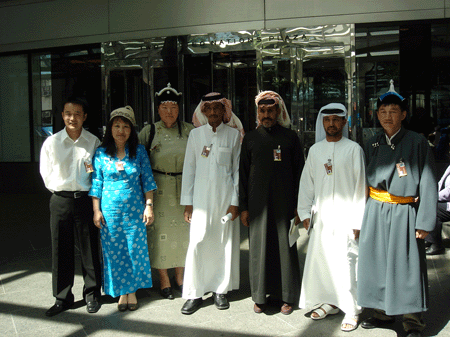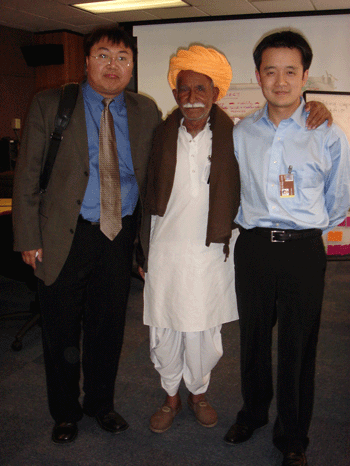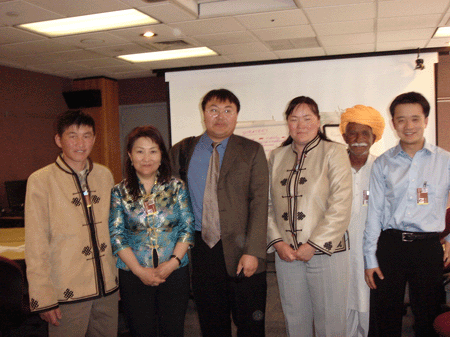| |
 |
|
| |
|
|
SMHRIC member
with mobile indigenous representatives from Mongolia and the
Middle East
|
|
|
 |
|
| |
|
|
SMHRIC members
with the camel herders' representative from India
|
|
 |
|
| |
|
|
After the WAMIP workshop at the UNDP
Building
|
|
Ladies and
gentlemen,
My name is
Enhebatu Togochog, and I represent the five million indigenous
Mongolian people of Inner Mongolia. I am honored to be here
today to talk about what is currently happening in Inner
Mongolia. As a typical Asian mobile indigenous people, the
Mongols have lived in Inner Mongolia for thousands of years
practicing their nomadic way of life. However, in 1947 the
Chinese Communist Party took control of Inner Mongolia causing
drastic changes in the region. After almost 60 years of Chinese
rule, the Inner Mongols are being forced to abandon their
traditional way of life and leave their ancestral land under a
series of forced policies from the authorities:
The first
is the forced eviction of Mongolian herders from their land
under slogans of “recovering grassland ecosystem” and “improving
herders’ living standard”. This policy was officially
implemented in 2001 when the government of Inner Mongolia passed
a set of legislations that directly targeted 650,000 herders
during the first 5-year phase. Ultimately, the legislations will
affect the entire herding and semi-herding population. Under
these laws and regulations that were designed, passed and
enforced by the government without consultation with the Mongol
herder population, it is currently illegal for the Mongols to
graze livestock in their own pastoral lands across the region.
The authorities’ justification for this policy is that the
Mongolian herders’ "backward, primitive, and low-productive”
traditional way of life is the root-cause of Inner Mongolian
environmental degradation. Currently “over-grazing” is a very
popular term often used by the Chinese official news media.
Ironically enough, there is no term in the Chinese authorities
dictionary called “over-cultivation”, despite the fact that 12
million Chinese peasants (as opposed to only 2.5 million Mongol
herders) are cultivating the already-weakened Inner Mongolian
land every spring.
The second
is the forced urbanization of Mongolian evictees. In the name of
“speeding up urbanization and industrialization of rural
communities," thousands of evicted herders are being forced to
resettle into overwhelmingly Chinese populated urban areas;
including big cities like Huhhot and Shiliin-hot, and newly
formed townships or the so-called “immigrant’s new villages” (“yi
min xin cun” in Chinese). Without the necessary skills and
financial incomes to survive in urban areas, these herders are
further marginalized in a Chinese dominated society. According
to a communication from Huhhot City, recently the Chinese
authorities have forcefully demolished a group of evicted
herders’ small businesses that were their only livelihood. In
another case, more than 40 Mongolian herder’s households from
Huveet-shar Banner of Shiliin-gol League were relocated to an
abandoned factory building in the outskirts of Huhhot City. With
no way to make a living, these herders asked for permission to
return to their land but their requests were turned down by the
authorities.
The third
is the forced elimination of Mongolian language and education.
As a continuing pattern of cultural assimilation, a policy was
adopted by the Chinese authorities in Inner Mongolia with the
goal of eliminating Mongolian language and Mongolian schools.
The main justification of this policy by the authorities is that
the Mongolian communities are “scattered across the vast land”
which makes it hard for the government to improve the quality of
education in rural pastoral areas. Therefore, the Chinese
authorities claim that the only way to overcome these
difficulties is to “concentrate and redistribute” Mongolian
schools. According to complaints from rural Mongolian
communities, under this policy almost all Mongolian elementary
schools at the level of Gachaa (the second smallest
administrative unit) are being eliminated, and most Mongolian
middle schools at the Sum level (the third smallest
administrative unit) are being merged into Chinese teaching
schools. Mongolian students are therefore left with no choice
but to learn Chinese.
Dear
friends, what I mentioned here is just the tip of the iceberg.
There are a lot more human rights issues in Inner Mongolia
waiting to be raised. If you are interested in exploring more,
please visit our website at www.smhric.org
Thank you.
Enhebatu
Togochog
Southern
Mongolian Human Rights Information Center (SMHRIC)
45-25
39th PL 2E
Sunnyside, NY 11104
U.S.A.
Tel:
001-718-786-9236
E-mail:
enhebatu@smhric.org
Webstie:
www.smhric.org
|





